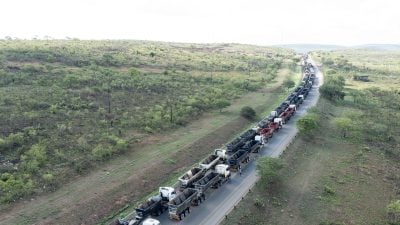Professionals from the global freight industry, which contributes up to 8% of global greenhouse gas emissions, say that the industry must adopt new solutions if it is to thrive in a post-Cop world of stricter environmental targets.
Speaking at the DP World Global Freight Summit in Dubai as climate negotiators hammer out new emissions targets at Cop27 in Sharm El-Sheikh, Egypt, Rajesh Garg, chief financial officer at Middle East retail and hospitality group Landmark Retail, said that governments and regulators must help the freight industry adapt to the new reality before the planet’s “Cinderella moment” in 2050, when global warming of more than 1.5 degrees Celsius above pre-industrial levels could cause irreversible planetary damage.
“I think unless the regulator or government pushes it will not happen or will happen at a slower pace, and as you know we are out of time. 2050 is the Cinderella moment for the planet and if we don’t work fast enough it’s too late. I think the regulators and government should step in and I’m hoping Cop28 [which will be held in the United Arab Emirates] should usher in a whole range of new initiatives, directives and programmes that the government can do to help all industries.”
Pressing need to use sustainable aviation fuel
The freight industry is a major contributor to global emissions, and without substantial reform its carbon emissions could double by 2050, according to MIT. Some of the most entrenched areas that the industry must tackle are fuel burned by the global freight shipping and aviation industries upon which much global trade depends.
Christina Struller da Costa, vice president for corporate affairs for the Indian Subcontinent, Middle East and Africa at US shipping firm UPS, said that the need for the industry to use sustainable aviation fuel is particularly pressing.
“It’s really important to work together, it must be in collaboration with government… on sustainable aviation fuel, right now the cost is not economically viable, we need to work together to find a solution. One percent of sustainable aviation fuel is available – we all need it. We really need to speed that up given that that’s the biggest impact on our emissions and very challenging.”
There has been some recent progress on the issue. In September, the US Department of Energy issued a government-wide strategy for ramping up production and use of sustainable aviation fuels, building on a September 2021 target to work with US airlines to supply at least 3bn gallons (11.36bn litres) per year by 2030 and enough by 2050 to meet 100% of aviation fuel demand, projected at 35bn gallons (132bn litres) a year.
The department said that fuels derived from lipid-based pathways – including fats, oils, and greases – are expected to be the primary fuel pathway leading up to 2030. By contrast, fuels derived from battery technologies and hydrogen “are not expected to contribute to substantially reducing aviation emissions until after 2050”.
Long road to sustainability
Tiemen Meester, group chief operating officer for ports and terminals at Emirati logistics company DP World, said that there is an “incredible amount of activity” on sustainability in the freight industry but that some of the answers are proving elusive. The Dubai-based firm has targeted CO2 neutrality by 2040 and zero CO2 emissions by 2050.
“To put it in simplistic terms we have a fleet of vessels, they run on fuel, we have ports that use diesel and electricity etc, and you need to make a plan for all of this to convert,” said Meester.
“Today I would say we have answers for about a third, maybe a little more, of how to do it. We’re executing electrification, buying renewable energy where we can, and actually creating renewable energy in some countries where governments cannot… This is a good journey. But this is a long journey and not something you solve in a few years.”
Freight airlines ‘aware of their responsibility’
Dennis Lister, vice-president for cargo commercial development at freight aviation company Emirates SkyCargo, said that freight airlines are particularly aware of their responsibility to reduce emissions given their normal perception as “the bad guys in the room”.
“From an Emirates and an industry standpoint it’s imperative that there needs to be more efficiency when you’re flying, that’s the bottom line. From our perspective we have a very young fleet of aircraft… [our] ambition is to make sure we can get more fuel-efficient aircraft – a lot more fuel-efficient so you get to the 20-30% range of improvement.”
Lister said that the firm is also converting old passenger aircraft to reduce its footprint and looking at reducing emissions in the other activities under its control.
“We have something called upscaling – we have the ability to convert old passenger aircraft into freighters. You’re not having to go and dig in the ground and get the raw material to build new aircraft.
“We continue to invest in newer aircraft, but when you fly an aircraft, it’s not just an aircraft operating but all the ancillary activities happening around it, above-wing and under-wing, that we have to consider.”
Sustainable solutions needed for ‘last mile’ deliveries
As well as aviation and shipping routes, there is also an immediate need to focus on the “last mile” of deliveries, which disproportionately contribute to emissions. According to MIT, road freight emits more than 100 times as much CO2 as a cargo ship to carry the same amount of cargo the same distance. The global rise of e-commerce in emerging markets like Africa is exacerbating the need for sustainable last-mile solutions.
Struller da Costa said that governments can collaborate with the industry in multiple ways to reduce delivery emissions, including prioritising railways for cargo, funding research and development on transitional technologies, and ramping up electric vehicle charging infrastructure to enable quicker electric vehicle rollout. She also called on governments to make it easier for firms to gain approvals and permits for delivery e-bikes to operate in major cities.
“We need to work on different approvals and permits so our e-bikes can go deliver packages, we need specific parking spaces for e-bikes. So there are a lot of opportunities to work with governments.”
E-commerce poses challenges
Robert Choy, global vice-president at Syncreon, said that while e-commerce is altering the face of the freight industry, pressure from younger, environmentally aware customers could also force change.
“Our kids are growing up in an environment where they’re so much more educated and in touch with the world, they want to do good and part of that is not consuming as much, and when they do, making the right decisions. Part of that consumption pattern that we grew up with – we have a garage full of goods we don’t use – with kids growing up now consumption is different and everything is done on their phones. They are spending more on virtual goods so maybe that satisfies that human nature.”
Choy said that the massive choice of goods offered by e-commerce – and the option to send back unwanted goods instantly – makes it imperative for the industry to consider how to streamline “return channels”.
“The rise of e-commerce makes it so much easier to click, buy a size bigger, smaller, and it all comes to your house, and what you don’t want you ship back. No one thinks twice about what happens to those goods but there are a lot of companies thinking about how you can streamline that, and that’s incredibly vital.”
Want to continue reading? Subscribe today.
You've read all your free articles for this month! Subscribe now to enjoy full access to our content.
Digital Monthly
£8.00 / month
Receive full unlimited access to our articles, opinions, podcasts and more.
Digital Yearly
£70.00 / year
Our best value offer - save £26 and gain access to all of our digital content for an entire year!
 Sign in with Google
Sign in with Google 



